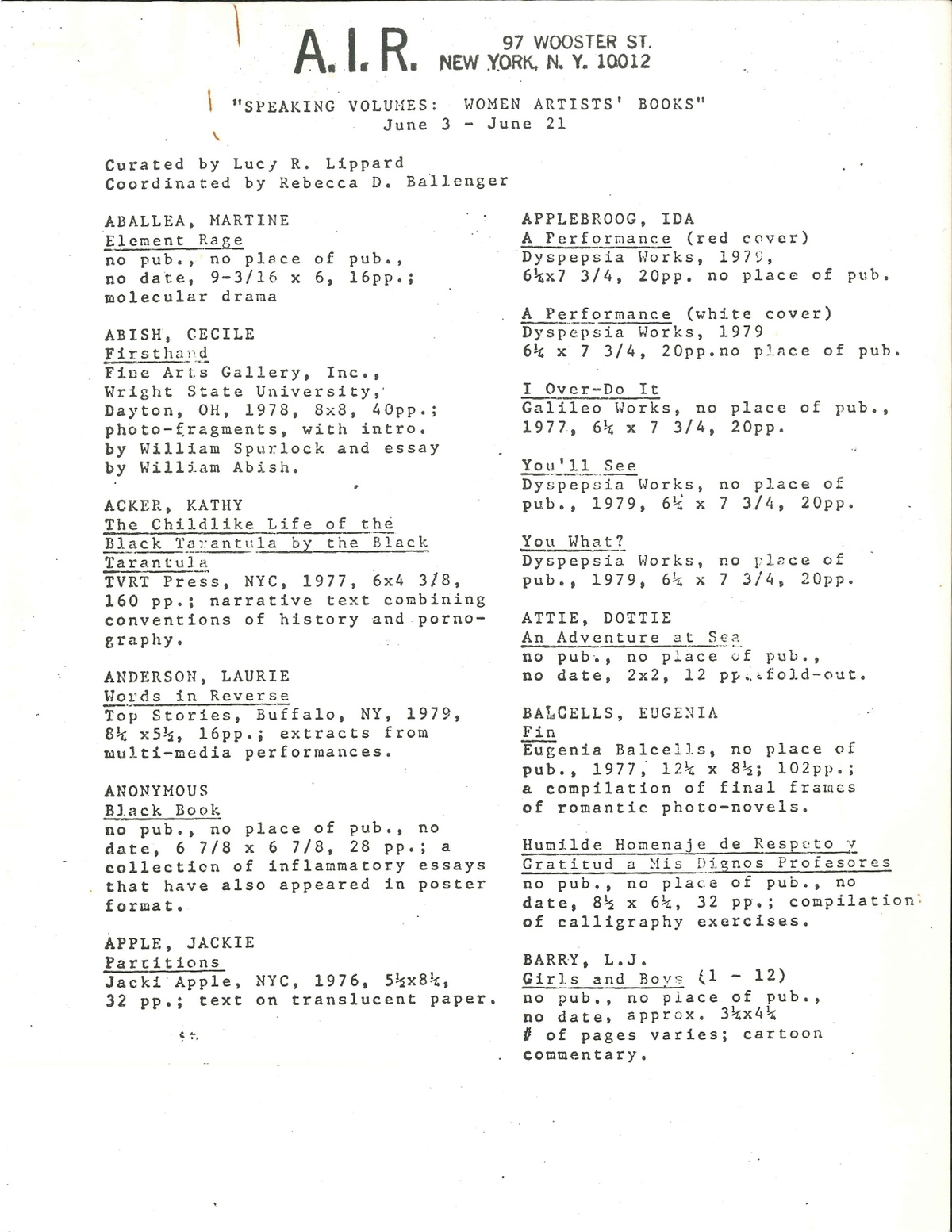A.I.R. Gallery — Checklist for Speaking Volumes: Women’s Artists’ Books
Megan Liberty Oct 7, 2022 2 Minute Read
This essay is featured in the digital exhibition A.I.R. Gallery: Chapter 3.
In May of 1980, critic Lucy Lippard organized Speaking Volumes: Women Artists’ Books at A.I.R. Gallery on Wooster Street. At the time, only six years after the collective’s founding, A.I.R. was already in the practice of creating much-needed space for work that was not offered attention in traditional gallery settings—such as art made by women and art in book form.
As the press release for the show proclaims, “In the past decade a great number of women have confided their lives, aspirations, rage, and humor to the pages of self-made books.” The exhibition checklist, a nine-page document located in the Fales Archive, details the over 100 books in the show, primarily self-published books, but also books published by galleries like Leo Castelli and arts institutions like Printed Matter and the Visual Studies Workshop Press in Rochester. The artists included Kathy Acker, Ida Applebroog, Agnes Denes, Sarah Charlesworth, Helen Douglas, Suzanne Lacy, Joan Lyons, Marcia Resnick, and Martha Rosler—the majority of whom continued to work with publications and printed matter throughout their careers. Coming off the heels of Printed Matter’s establishment in 1976—of which Lippard was a founder—the show is part of a group of early efforts by a number of institutions, including A.I.R., to reify artists’ books as an art form and provide space for their exhibition and distribution.

Digitized as part of a partnership between A.I.R. Gallery and The Feminist Institute, 2022. See record
More than just a list of objects, the checklist captures an important moment in the history of artists’ books. Artists’ books are a nexus of literature, publishing, and printmaking, and as a consequence, don’t lend themselves to straightforward tombstone descriptions. As a historical artifact, the Speaking Volumes checklist is an invaluable record of these efforts to find language for this still-emerging practice. In addition to the basic details—artist, date, size, pages—it also includes brief descriptor lines. For example, Acker’s The Childlike Life of the Tarantula by the Black Tarantula (1977) is described as “narrative text combining conventions of history and pornography” and Barbara Ess’s Grammar Play (1978) is documented as “pictures and text from found children’s grammar book, eclectically rearranged.” These lines fall somewhere between a traditional book description and an artwork description, illustrating the challenge of artists’ books present in both their display and description. To today’s readers, these short lines may feel outdated compared to the lengthy descriptions of artists’ books used in contemporary didactics, or the more minimal approach of forgoing an interpretive narrative in favor of just listing materials and process. But the descriptors were common at the time and show the ways in which distributors and exhibitors hoped to introduce the media of the artist book itself to their audience. Some of these lines are more representative than others: Jenny Holzer’s A Little Knowledge Can Go A Long Way. Your Oldest Fears Are the Worst Ones (1977) is listed as “aphorisms, maxims, clichés, truisms” words that could easily describe her practice more broadly, and Charlesworth’s Modern History (Second Reading) is accompanied by “documentary ‘unwriting’ history”—again evocative of her broader approach to art-making. Others add more mystery than clarity, such as Poppy Johnson’s (Untitled, blue book) (1977), an “autobiographical text written in performance,” with no explanation of what “written in performance” means.
Speaking Volumes is no doubt a landmark exhibition, evidenced by the sheer volume of artists involved. Focusing on the checklist, in particular, we can also see this show as one of many early attempts in the search for artists’ book qualifiers—for a vocabulary to convey an essential, ineffable, and excitingly challenging artist bookness.
Megan N. Liberty is the Art Books section editor at The Brooklyn Rail and co-founder of Book Art Review. She writes about artists’ books, ephemera, archives, and other multidisciplinary meetings of text and image for Hyperallergic, ArtReview, Artforum.com, art-agenda, Art in America, Frieze, and elsewhere. She lectures widely on artists’ publishing and books and has been invited to speak at Boston University, Mills College, New School, and SMFA Tufts. She was a 2019–20 AICA/USA and Creative Capital/The Andy Warhol Foundation’s Arts Writing Workshop participant and has a Master’s in Art History from the Courtauld Institute of Art.